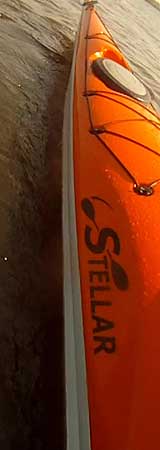As the wind was NW 4-5 bft today, this seems an opportunity to paddle the kayak to the club-evening at night and at the same time test the kayak. Total distance 19km.
I took a GPS with me to get an impression of the speed I can reach with this kayak. My natural solo-pace in this kayak turns out to be 8,5 km/h. Only a bit slower in a head-wind and a bit faster in a tail-wind. When I entered a wind-free area I reached 9/km/h immediately. I think that this is not bad at all for a seakayak. Anyway: faster than the average seakayak.
I will do the sprinting later when there is no wind, but looking at the way the kayak cuts the water, she must be quite fast.
While paddling I discovered that the sloped surfaces, left and right, in the deck, which could make the paddle stroke more efficient because of entering the water with the blades closer to the hull, are too far aft. The sloped surfaces look very good in the current position, but are not functional because the paddle blades enter the water farther away to the front.
Afterwards looking at the paddle-scratch-marks on the deck, I concluded that these surfaces should move towards the bow over approx. 35 cm. A positive spin-off will be that the chart-table-elastics (read article "first glance") can be positioned better as well.


The seat and the cockpit are comfortable. About the knee-contact I have some remarks. But because every paddler has different legs this is a personal remark: the thighs does not touch the thigh-grips (they could be placed more aft for me) and the kneecaps have a direct, unpleasant contact with the deck next to the cockpit-rim. I will investigate if I can solve that for me with a layer of foam underneath the thigh-grips.
The width of the seat was a bit to wide, not providing hip-contact for easy edging. So I will fill up the space with foam as well.
The feet-rests are the usual pegs on a rail. The have a rather nice profile and are very easy to adjust; even when sitting in the cockpit already.
Because I personally don't like foot-pegs at all I sled a wide plastic tube over the pegs: my invention which gives me the opportunity to move the feet (and thus the legs) to different positions.
I would not advise to use the front bulkhead as foot-contact because it is very flexible. I can not judge if it can withstand the high pressure I can have when paddling hard.
When paddling on the canal the kayak weathercocks quite a lot but by lowering the retractable skeg maximal, this was compensated.
When entering the lake the SI18 responds very lively at the waves. She runs slices nicely over and through the waves, almost without producing spray.
The primary stability is reasonable good. The secondary stability is very good.
I paddled still with the skeg down and the kayak tracked very well in the waves (of approx. 40cm heigth).
When hauling the skeg up she started weathercocking again. In this wind it was difficult to correct for that with paddles strokes and edging. I wonder what a stronger wind will have for effect. I certainly will test-paddle this kayak later in stronger wind.
When turning upwind this was very easy because the kayak does that herself already when not using the skeg. Turning downwind is difficult as the skeg was dropped maximal yet. I could not manage to turn down wind other than stopping and make contra-paddlestrokes as well.
Arriving at the club I was a bit disappointed because my fleece jacket, stored in the aft-compartment, was wet. The other compartments were still dry. So probably I closed the aft-hatch not exactly positioned.
My way back home in the middle of the night meant today that the wind was gone; already at sleep I guess.
This was a good condition to feel that this kayak is very maneuverable. Really she turns on a dime.
She also responds very good to edging feeling secure in the secondary stability as well.
On the mirror-like water-surface I discovered fully how maneuverable the kayak is. Even when paddling a straight line the kayak tracks less and you can see the bow moving left to right a bit at every stroke. No problem because she is so easily back on course again. When having hip contact you even don't need paddle strokes for that because leaning a bit helps enough already. But when you are in a lazy mood, just drop the skeg a bit and she tracks very good again. Personally I like this behavior because you have the choice being good-tracking or maneuverable at the moment you like. So you can adjust the behavior to the situation you are in.
The operation of the skeg was convenient with a knob that you have perfect grip on. Operation is without any friction. The only thing I wonder about is if the wire, to which the operation-knob is added is not to thin. I wonder if in any rescue situation someone could grab the wire accidentally out of the slot.
To be continued
